
 Predict
Predict
The use of the earlier aspects will do much to establish what are the critical areas for measurement: Customer measures (Purpose). Performance measures (Philosophy), Staff measures (People), and in-process measures (Process). This section looks at how those measures might be taken forward.
 Management
needs to ensure a balanced approach to this, and to provide practical
means for ensuring key data is available to demonstrate how well
they are executing their responsibility for performance. An effective
means for reporting the essentials succinctly is the Quadrant
Chart (shown right).
Management
needs to ensure a balanced approach to this, and to provide practical
means for ensuring key data is available to demonstrate how well
they are executing their responsibility for performance. An effective
means for reporting the essentials succinctly is the Quadrant
Chart (shown right).
Quadrant Charts provide a succinct and comprehensive means of reporting that the business is in control, but it can be further supported by other tools to help determine the measures, and undertake the analysis. Some of these are outlined below:
The Balanced Scorecard, provides a means for thinking through a comprehensive dashboard of measures to help manage the business at the top level.
Modelling & MIS can bring the power of computers to bear on the generation and analysis of measurement data.
Problem Solving, approaches can help to ensure that observed deficiencies are effectively tackled at root cause, and the Toolkit that supports the discipline can provide further insights when required.
Risk Management, can help people to think forward in order to avoid areas of risk, and also to suggest measurements which can indicate imminent problems.
Training, in measurement and problem solving, can do much to ensure people develop a systematic approach and to develop disciplined attitudes.
Finally, Business Audit can help the business to reassess its measurement approach and ensure it stays in tune with business need.
Please click on the diagram below (or on the associated text) to explore the various approaches that have been used to enhance Management's ability to 'Predict' within organisations.
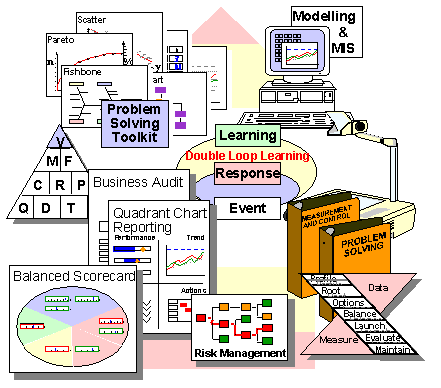
Double Loop Learning, Quadrant Chart, Balanced Scorecard,
Business Audit, Measurement Logic, Problem Solving Tools
 Measurement
is the key to a systematic approach to management. Effective
measurement is the key to understanding the business, the main
challenge to complacency in the business, and the validation
of successes from the business. And yet in many organisations
measurement has progressed little beyond a basic financial evaluation,
or quantification of numbers that have a direct relationship
to that finance.
Measurement
is the key to a systematic approach to management. Effective
measurement is the key to understanding the business, the main
challenge to complacency in the business, and the validation
of successes from the business. And yet in many organisations
measurement has progressed little beyond a basic financial evaluation,
or quantification of numbers that have a direct relationship
to that finance.
Part of the reason for this is the political abuse of measurement - inferring conclusions that are only part of the whole picture - and part of it is the lack of use of the measurement data - in failing to follow up and make the improvements that the measurements imply are required.
But perhaps the biggest factor in practice is that people are not clear on 'what' to measure. One excellent source of guidance on this is the book "Measure Up" by Lynch & Cross which illustrates an hierarchical approach to measurement
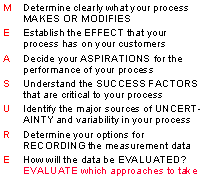 The
hierarchy proposed starts with the vision and then breaks
this down into the two areas of market measures and financial
measures at the business unit level, then into the three areas
of customer satisfaction measures, of flexibility
measures, and of productivity measures at the process
level, and all this is built on measures of quality, delivery,
cycle time and waste at the activity level.
The
hierarchy proposed starts with the vision and then breaks
this down into the two areas of market measures and financial
measures at the business unit level, then into the three areas
of customer satisfaction measures, of flexibility
measures, and of productivity measures at the process
level, and all this is built on measures of quality, delivery,
cycle time and waste at the activity level.
Further guidance on defining practical measures can be obtained from the resources section of this web-site. The guide on measurement can be downloaded, and proposes the use of the acronym M.E.A.S.U.R.E. as a guide to helping people to think through what they might measure in practice. The basis for this acronym is shown to the right.
 The
Balanced Scorecard was an approach to measurement proposed by
Kaplan and Norton in the Harvard Business Review in 1992. The
key message in their article concerned the need to ensure a balanced
set of measures at the top level of the business, in order to
ensure that management kept a longer term perspective than they
traditionally developed through a largely financial measurement
perspective. The basic concept of 'balance' has been increasingly
adopted since then, and now there are fewer companies that manage
on a purely financial perspective.
The
Balanced Scorecard was an approach to measurement proposed by
Kaplan and Norton in the Harvard Business Review in 1992. The
key message in their article concerned the need to ensure a balanced
set of measures at the top level of the business, in order to
ensure that management kept a longer term perspective than they
traditionally developed through a largely financial measurement
perspective. The basic concept of 'balance' has been increasingly
adopted since then, and now there are fewer companies that manage
on a purely financial perspective.
The 'balanced scorecard' approach has become popular, and there are now many proponents of it. They generally propose four areas in which measurement should be developed, and these typically include: customer measures, employee measures, and innovation measures, as well as the financial measures. From a systematic perspective this is clearly an improvement, and parallels can be drawn with the six aspects listed on the left.
 Computers
have done a tremendous amount to make the analysis and presentation
of measurement data easy, attractive and meaningful. With the
increasing use of computers in business, the advent of intranets,
increased use of e-mail etc., the potential for computers to
gather analyse and present measurement data is likely to increase
still further. And the objectivity that such impartial analysis
can provide is key to overcoming the subjective prejudices we
all have in looking at situations clearly - where our history,
partial perspectives, and sentiment can partly blind us to the
realities of the situation (see diagram below right).
Computers
have done a tremendous amount to make the analysis and presentation
of measurement data easy, attractive and meaningful. With the
increasing use of computers in business, the advent of intranets,
increased use of e-mail etc., the potential for computers to
gather analyse and present measurement data is likely to increase
still further. And the objectivity that such impartial analysis
can provide is key to overcoming the subjective prejudices we
all have in looking at situations clearly - where our history,
partial perspectives, and sentiment can partly blind us to the
realities of the situation (see diagram below right).
 Management
Information Systems (MIS) have profited greatly from the increasing
use of computers for management tasks, and in many systems it
is now possible to understand performance issues as and when
they occur, and to interrogate the system to identify the problem
almost instantly.
Management
Information Systems (MIS) have profited greatly from the increasing
use of computers for management tasks, and in many systems it
is now possible to understand performance issues as and when
they occur, and to interrogate the system to identify the problem
almost instantly.
The use of computers also gives the potential for modelling. Their ability to process vast amounts of data makes it a relatively simple task for them to explore patterns and trends, to use artificial intelligence algorithms, and to model the likely outcomes to events and options.
Computers make the concept of 'Predict' increasingly viable.
 Effective
measurement can do much to ensure business performance is improved.
It must be remembered however that measures only answer the question
we ask. What happens if we ask the wrong questions? If our measures
are looking at the wrong thing it is still possible for us to
go disastrously wrong. Just because delivery accuracy and product
quality improve it does not automatically result that our customers
are more satisfied.
Effective
measurement can do much to ensure business performance is improved.
It must be remembered however that measures only answer the question
we ask. What happens if we ask the wrong questions? If our measures
are looking at the wrong thing it is still possible for us to
go disastrously wrong. Just because delivery accuracy and product
quality improve it does not automatically result that our customers
are more satisfied.
The measures we select are likely to give us a fair indication that we are 'going right', but some of those measures will be partial, or approximations to what is really happening. Some of the things that are important to us are just too difficult, expensive or disruptive to measure comprehensively on a regular basis.
Business Audit gives companies the means to check that their measures are continuing to reflect an accurate and complete picture. By means of a sampled or annual investigation the audit can provide a complete picture of the current business situation, and in this way can be used to validate or improve measurement methods where appropriate.
Business Audit also gives the opportunity to ensure that the data arising from the measures is being used effectively to drive improvement. In Rank Xerox the senior levels of management are the people who undertake the audit (an approach they call Business Excellence Certification) and this gives them the opportunity to challenge and coach the business appropriately.
 Most
inefficiencies and problems exist in business because the business
is not good at solving problems. Often the business itself wont
see things quite this way - they will think they are good at
it - after all they have lots of experience, they spend most
of their time doing it, and some problems they solve many times
over.
Most
inefficiencies and problems exist in business because the business
is not good at solving problems. Often the business itself wont
see things quite this way - they will think they are good at
it - after all they have lots of experience, they spend most
of their time doing it, and some problems they solve many times
over.
But if you look at how the problems
have been tackled you may see that in the urgency to develop
a solution quickly some things get overlooked: for instance different
parties see the problem differently; or the cause addressed is
not really the root cause; or the options were not fully
thought through; or the solution was really just a quick fix;
or the implementation was not fully planned, or checked to see
if it was really working; or the situation drifted back to how
it was originally once the spotlight moved away. It is our experience
that the majority of attempts to solve problems in business suffers
from one or more of these issues, and the result is far from
ideal, and often it fails in the long term. 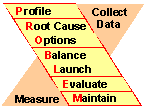
Problems are solved efficiently and effectively by avoiding the problems listed above. In practice this is best achieved by having a disciplined approach. At its simplest this may just be a checklist, or for more complex problems, it could be a complete methodology with procedures and review points. The P.R.O.B.L.E.M. approach is both of these at its simplest it is a checklist of the steps to work through (see the diagram on the right), but it is also a guide with defined tools and quality control paperwork. A guide to P.R.O.B.L.E.M. can be found in the resources section.
The essence of problem solving lies in measurement and quantification, and it would not be stretching things too far to explain it as a special case of measurement - initially to explore the dimensions and causality of the problem, subsequently to prove and ensure the solution, and finally to maintain the improvement made.
 Problem
Solving relies on the quality and depth of the perspective that
is developed by the problem solver (or problem solving team).
Where that perspective is shallow, inaccurate and subjective
the success of the final solution is fragile and incomplete.
The problem solving tools exist to drive a greater quality and
depth of perspective by forcing explicit discussion and exploration
of the situation.
Problem
Solving relies on the quality and depth of the perspective that
is developed by the problem solver (or problem solving team).
Where that perspective is shallow, inaccurate and subjective
the success of the final solution is fragile and incomplete.
The problem solving tools exist to drive a greater quality and
depth of perspective by forcing explicit discussion and exploration
of the situation.
The most common Problem Solving Tools are Brainstorming, Fishbone, Tally-sheet, Pareto Diagram, Scatter Diagram, Flowchart and Run Chart, these are outlined briefly below, or can be investigated in more depth by downloading the basic guide to Problem Solving Tools from the Resources section.
 Brainstorming is a method of generating ideas and
thoughts in a group by answering a question of the form "In
how many ways ...?" and getting the group to bounce off
each others ideas - avoiding any selection or judgment until
the 'generation' is complete. It is a very simple tool and widely
used (or often abused). Its strength lies in the suspension of
judgment until the generation of ideas is finished - but this
is the primary area that many would-be brainstorms fall down.
Brainstorming is a method of generating ideas and
thoughts in a group by answering a question of the form "In
how many ways ...?" and getting the group to bounce off
each others ideas - avoiding any selection or judgment until
the 'generation' is complete. It is a very simple tool and widely
used (or often abused). Its strength lies in the suspension of
judgment until the generation of ideas is finished - but this
is the primary area that many would-be brainstorms fall down.
Return to top of section on Problem Solving Tools
 The Fishbone
diagram (also known as the Ishikawa and Cause-and-Effect diagram)
is a form of structured brainstorm to identify all the possible
causes to a problem. The 'legs' of the fishbone represent different
areas of possible cause eg. Manpower, Machinery, Method, Materials,
and suggestions are brainstormed against these. The fishbone
structure helps to ensure a more comprehensive consideration
of the problem. Normal brainstorming rules apply, and if you
can't find a daft suggestion on the fishbone at the end then
the exercise is probably incomplete - in business we close things
down all to easily, our problem often lies in not being effective
at opening things up.
The Fishbone
diagram (also known as the Ishikawa and Cause-and-Effect diagram)
is a form of structured brainstorm to identify all the possible
causes to a problem. The 'legs' of the fishbone represent different
areas of possible cause eg. Manpower, Machinery, Method, Materials,
and suggestions are brainstormed against these. The fishbone
structure helps to ensure a more comprehensive consideration
of the problem. Normal brainstorming rules apply, and if you
can't find a daft suggestion on the fishbone at the end then
the exercise is probably incomplete - in business we close things
down all to easily, our problem often lies in not being effective
at opening things up.
Return to top of section on Problem Solving Tools
 The Tallysheet
is a simple mechanism for collecting data in a non-bureaucratic
way. Typically it lists down the left hand side some likely causes
selected from the Fishbone diagram, and against these an operator,
or in some cases an observer, keeps a tally of the occurrences
of each of the causes. At the end of the observation period the
tally is counted to see which causes are most predominant. The
tool is so simple that there is a danger of thinking it trivial,
but it is our observation that its use leads to better quality
of analysis and discussion. Where we have left people to record
things in their own way we have normally regretted it.
The Tallysheet
is a simple mechanism for collecting data in a non-bureaucratic
way. Typically it lists down the left hand side some likely causes
selected from the Fishbone diagram, and against these an operator,
or in some cases an observer, keeps a tally of the occurrences
of each of the causes. At the end of the observation period the
tally is counted to see which causes are most predominant. The
tool is so simple that there is a danger of thinking it trivial,
but it is our observation that its use leads to better quality
of analysis and discussion. Where we have left people to record
things in their own way we have normally regretted it.
Return to top of section on Problem Solving Tools
 Pareto Diagrams provide a very good way of graphically
representing the data from tally charts (or other investigations).
They sequence the data in order of importance, and present a
cumulative picture of the effect of various causes. Named after
an Italian Economist, they help to reinforce the 80/20 rule that
we can often solve 80% of the problem by addressing the right
20% of the causes.
Pareto Diagrams provide a very good way of graphically
representing the data from tally charts (or other investigations).
They sequence the data in order of importance, and present a
cumulative picture of the effect of various causes. Named after
an Italian Economist, they help to reinforce the 80/20 rule that
we can often solve 80% of the problem by addressing the right
20% of the causes.
Return to top of section on Problem Solving Tools
 Sometimes the
cause of a problem is more obscure and it is not easy to attribute
causes easily, as with a tally chart. In these cases the Scatter
Diagram can provide insight into whether there is a clear
relationship between cause and effect. The cause, and the 'suspected'
effect, are both quantified and plotted against each other on
graph paper. Over time this results in a number of crosses that
either form a shapeless mass (where there is no clear relationship)
or some form of broad diagonal line (where the 'suspected' cause
clearly influences the effect). As an example you might consider
whether daily temperature influences daily ice-cream sales using
a Scatter Diagram.
Sometimes the
cause of a problem is more obscure and it is not easy to attribute
causes easily, as with a tally chart. In these cases the Scatter
Diagram can provide insight into whether there is a clear
relationship between cause and effect. The cause, and the 'suspected'
effect, are both quantified and plotted against each other on
graph paper. Over time this results in a number of crosses that
either form a shapeless mass (where there is no clear relationship)
or some form of broad diagonal line (where the 'suspected' cause
clearly influences the effect). As an example you might consider
whether daily temperature influences daily ice-cream sales using
a Scatter Diagram.
Return to top of section on Problem Solving Tools
 The Flowchart
is covered in some detail in the preceding section on 'Process'.
The disciplines of Flowcharting help to ensure a clear and complete
picture of what happens in practice, and the final result is
useful for thinking through cause and effect (fishbone - there
is a specialised version of the fishbone that is based on the
process flowchart) and for considering solutions.
The Flowchart
is covered in some detail in the preceding section on 'Process'.
The disciplines of Flowcharting help to ensure a clear and complete
picture of what happens in practice, and the final result is
useful for thinking through cause and effect (fishbone - there
is a specialised version of the fishbone that is based on the
process flowchart) and for considering solutions.
Return to top of section on Problem Solving Tools
 The Runchart
provides a means of observing performance over time. At the outset
of problem solving it can illustrate problems in variability,
and at the conclusion of the problem solving it can check and
validate the quality of the solution chosen - or indicate the
need for further work.
The Runchart
provides a means of observing performance over time. At the outset
of problem solving it can illustrate problems in variability,
and at the conclusion of the problem solving it can check and
validate the quality of the solution chosen - or indicate the
need for further work.
Return to top of section on Problem Solving Tools
 If
measurement is the engine that drives systematic management,
then the Quadrant Chart acts as the transmission, wheels and
tyres. The Quadrant Chart reports on one side of a sheet of A4
paper all that is relevant about the performance and management
of an area.
If
measurement is the engine that drives systematic management,
then the Quadrant Chart acts as the transmission, wheels and
tyres. The Quadrant Chart reports on one side of a sheet of A4
paper all that is relevant about the performance and management
of an area.
In the top left-hand quadrant
the chart displays the key measures of the area's (department,
process, section...) performance, the target to be achieved and
the current level of performance. 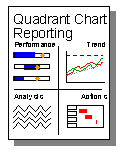
In the top right hand quadrant it graphs the performance and trend against target for the year to date and thereby illustrates any trend issues in the performance of the area.
In the bottom left hand quadrant it provides a summary of the analysis that has been undertaken into any performance issues, whether overall performance or adverse trends.
And in the bottom right hand quadrant it summarises the actions that have been planned to address the issues and bring the performance back into control.
The quadrant chart demonstrates clearly on one piece of paper what is being managed and what is not - it reports the basics baldly and provides little scope for hiding issues in a mass of rhetoric. And it is quick and easy to produce (If of course you are managing systematically - otherwise it is a real pain!)
 Double
Loop Learning was a term coined by Chris Argyris to represent
the need to move out of unproductive responses and think at a
higher level about what is going on (A sort of Top-Box concept).
Double
Loop Learning was a term coined by Chris Argyris to represent
the need to move out of unproductive responses and think at a
higher level about what is going on (A sort of Top-Box concept).
The idea is that when our normal ways of responding to situations prove only partially successful we need to re-think them at a higher level. For instance if we rebuke someone for shoddy work, because it has addressed the problem in the past, we may need to see that the problem does recur over time and consider a new and more lasting strategy. Basically Double Loop Learning causes us to look at data at a higher level and to observe trends that indicate more fundamental issues.
An example of Double Loop Learning is the questions asked of one company during their preparation for the Deming Award. Their Japanese Advisors asked them four questions:
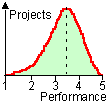 1.
How many improvement projects did you run last year? - the answer
was around 500
1.
How many improvement projects did you run last year? - the answer
was around 500
2. What was the performance of those projects in achieving their stated goals? - The company had already done an analysis of this, and presented the graph on the right.
3. How many improvement projects will you run next year? The answer was again around 500.
4. What will be the performance
of these? At this point the company realised that learning needs
to take place systematically and at a number of different levels.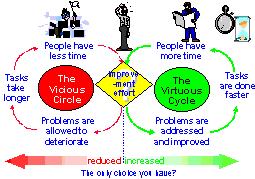
Too often though this type of learning - while extremely important is low priority because it is not urgent - but the problem is that this is a degenerative cycle. The learning is low priority because of the high priority issues that have arisen where learning has not been undertaken in the past - because it was low priority then too. The only real choice management has is how much of their time they will invest in learning and improvement - after this much of what happens is predestined (see diagram on the right)
 Risk
Management is a special form of information gathering. It concerns
not what actually is, but what might be. Risk Management is about
predicting the causes of problems and issues before they arise
rather than dealing with them and learning from them afterwards.
The idea is to use forethought to consider what might go wrong
and then to set contingencies or avoidance/prevention strategies
against those risks which are particularly high priority (highly
likely or high impact).
Risk
Management is a special form of information gathering. It concerns
not what actually is, but what might be. Risk Management is about
predicting the causes of problems and issues before they arise
rather than dealing with them and learning from them afterwards.
The idea is to use forethought to consider what might go wrong
and then to set contingencies or avoidance/prevention strategies
against those risks which are particularly high priority (highly
likely or high impact).
Risk management can be developed out of the PDPC covered in the previous section 'Process' in the explanation of the Management & Planning Toolkit. Or it can be done by brainstorming. Risk Management needs to be undertaken with a great deal of care - two pitfalls are quite common: not doing it at all, or doing nothing with the results on the one hand; or on the other becoming incapacitated by the sheer number of risks - often known as Analysis Paralysis.
 The
tools covered in this section - from basic measurement through
to tools to understand the information in more detail and make
decisions on it - are all fairly simple. But people are often
ignorant of what the tools are, or why they should use them.
They may well see quick reactions, macho calls, and firefighting
as the things to respect and aspire to - a self-fulfilling approach.
The
tools covered in this section - from basic measurement through
to tools to understand the information in more detail and make
decisions on it - are all fairly simple. But people are often
ignorant of what the tools are, or why they should use them.
They may well see quick reactions, macho calls, and firefighting
as the things to respect and aspire to - a self-fulfilling approach.
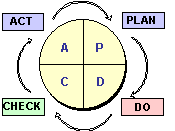 Training
is needed to develop a common disciplined approach and to reset
the attitudes of the organisation to more responsible and systematic
approaches. In particular training is needed to get across to
people the importance of a Plan, Do, Check, Act (or Learn) cycle
in all aspects of management, and this is critical where there
is little objective explicit evidence of this cycle in normal
management practice within the company.
Training
is needed to develop a common disciplined approach and to reset
the attitudes of the organisation to more responsible and systematic
approaches. In particular training is needed to get across to
people the importance of a Plan, Do, Check, Act (or Learn) cycle
in all aspects of management, and this is critical where there
is little objective explicit evidence of this cycle in normal
management practice within the company.
© Tesseract Management Systems Ltd 2003
(click below for an oversight)
Case studies of success
Managing by Design
- a handbook of
Systematic Mgt.
(purchase on line)
Transforming performance through QFD
(insight)
Testimonials on systematic management
(for Predict)
Overview
Principles
Self-Evaluation